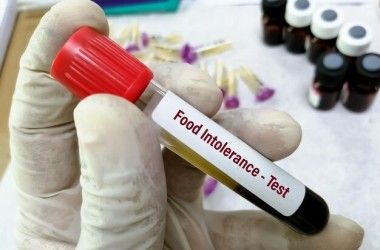General Health
Food Intolerance Test: Purpose, Procedure, Range, and Results
8 min read
By Apollo 24|7, Published on - 13 February 2025
Share this article
0
0 like

Food intolerance is a condition that can cause a range of uncomfortable symptoms after consuming certain foods. It can be difficult to pinpoint the exact food or ingredient responsible for these symptoms, especially since food intolerance often involves delayed reactions and can mimic other conditions. One of the most effective ways to identify food intolerance is through a food intolerance test.
In this article, we’ll explore everything you need to know about food intolerance testing, including its purpose, procedure, what the test results mean, and how to use the information to manage symptoms and improve your quality of life.
What is Food Intolerance?
Food intolerance is a non-allergic food reaction that occurs when your body has difficulty digesting or processing certain foods. Unlike food allergies, which involve the immune system, food intolerance is typically related to the digestive system. The symptoms of food intolerance can vary but commonly include bloating, gas, abdominal pain, diarrhoea, and fatigue. These symptoms may appear several hours after eating the offending food, making it harder to identify the cause.
Common food intolerances include:
- Lactose intolerance (difficulty digesting milk or dairy products)
- Gluten intolerance (sensitivity to wheat and other gluten-containing foods)
- Fructose intolerance (difficulty digesting certain sugars found in fruits and vegetables)
- Histamine intolerance (sensitivity to foods that release histamine, such as fermented foods, alcohol, and aged cheeses)
While food intolerance doesn’t pose an immediate life-threatening risk like food allergies, it can significantly affect your daily life and overall well-being. That’s why it’s important to identify the specific foods that trigger your symptoms, and food intolerance testing can be an essential tool in this process.
The Purpose of Food Intolerance Testing
Food intolerance test are designed to help identify the specific foods or ingredients that may be causing symptoms in individuals who experience digestive issues, discomfort, or other related symptoms. These tests are often recommended for individuals who have not been able to determine the source of their symptoms through trial and error or those who are looking for a more objective way to pinpoint their food triggers. Here are the primary purposes of food intolerance testing:
1. Identify Food Triggers: Food intolerance testing can help you figure out which foods are causing discomfort or digestive problems. With this information, you can make smarter choices about what to eat and avoid the foods that are making you feel unwell.
2. Relieve Symptoms: Once you know which foods are causing your symptoms, you can adjust your diet to avoid them. This can help reduce or even eliminate uncomfortable issues like bloating, gas, and stomach pain.
3. Improve Quality of Life: By eliminating the foods causing intolerance, individuals may experience fewer digestive issues, better energy levels, and an overall improvement in health and well-being.
4. Support Management of Underlying Conditions: Food intolerance testing can be really helpful for people with conditions like irritable bowel syndrome (IBS), chronic fatigue syndrome, or fibromyalgia, where certain foods might make symptoms worse. By identifying these triggers, individuals can better manage their condition and feel more in control of their health.
How Does Food Intolerance Testing Work?
Food intolerance testing is typically performed through a blood test, a skin test, or an elimination diet. Here’s a closer look at the common procedures used to test for food intolerance:
1. Blood Tests (IgG Testing)
One common way to test for food intolerance is through a blood test that measures the levels of immunoglobulin G (IgG) antibodies. These antibodies are produced by your immune system when it reacts to certain foods. For this test, a small blood sample is taken and analysed to see if there are elevated IgG levels against specific foods. High levels of these antibodies could suggest that you're intolerant to those foods.
Procedure:
- A healthcare professional will collect a small sample of your blood.
- The blood is then analysed in a laboratory to check for reactions to various foods.
- The results typically include a list of foods that have triggered an IgG response, indicating a potential intolerance.
2. Skin Prick Tests
Skin prick tests are most commonly used for diagnosing food allergies, but in some cases, they may also be used to assess food intolerance. During the test, small amounts of various food allergens are placed on your skin, and the skin is then lightly pricked to allow the substances to enter. If you are intolerant to any of the foods tested, you may experience redness or swelling at the test site.
Procedure:
- A small amount of food extract is placed on your skin, usually on your forearm or back.
- A small needle is used to make a tiny puncture in the skin.
- Results can be seen within 20 minutes, and any allergic or intolerance reaction is noted.
3. Elimination Diet
An elimination diet is another approach to identifying food intolerances. In this method, you remove suspected foods from your diet for a period of time, usually 4 to 6 weeks, and then gradually reintroduce them one at a time. This process allows you to observe if and when symptoms return after reintroducing a particular food.
Procedure:
- Work with a healthcare provider or dietitian to remove suspected food triggers from your diet.
- Keep track of any changes in your symptoms during the elimination phase.
- After a set period, slowly reintroduce foods and monitor for any reactions.
- While this method may take longer than other tests, it’s a highly effective way to identify food intolerances without the need for laboratory testing.
What is the Range of Food Intolerance Tests?
Food intolerance tests can vary in terms of the number of foods they test for, depending on the provider and the type of test. Most tests will analyse anywhere from 40 to 200 different foods, including common allergens like dairy, gluten, eggs, nuts, soy, and more.
A typical food intolerance test may assess:
- Dairy products (e.g., milk, cheese, yoghurt)
- Gluten-containing foods (e.g., wheat, barley, rye)
- Fruits and vegetables (e.g., apples, broccoli, tomatoes)
- Processed foods and additives (e.g., preservatives, artificial colours)
- Nuts and seeds (e.g., almonds, peanuts, sesame)
- Meats and seafood (e.g., chicken, fish, beef)
The range of foods covered by a test can provide a comprehensive view of potential food sensitivities. However, it’s important to note that no test is 100% definitive, and results should be considered in conjunction with a healthcare provider’s recommendations.
Understanding Your Food Intolerance Test Results
Once you’ve undergone food intolerance testing, the results will typically indicate which foods may be contributing to your symptoms. The results can be displayed in various formats, including a list of foods with corresponding intolerance levels or a score for each food tested.
Results are usually categorised as follows:
- High Intolerance: Foods that have a significant reaction in the test, indicating a strong intolerance.
- Moderate Intolerance: Foods that show a moderate reaction, suggesting that they may cause mild symptoms.
- Low or No Intolerance: Foods that show little to no reaction, suggesting that they are unlikely to be causing your symptoms.
It’s important to remember that food intolerance tests, particularly those that use IgG antibody testing, are not always definitive. False positives or negatives can occur, and the symptoms you’re experiencing may not always be directly related to the foods identified in the test.
Using Food Intolerance Test Results to Manage Your Symptoms
Once you have identified the foods that trigger your symptoms, the next step is to adjust your diet to avoid them. This may involve:
- Eliminating Trigger Foods: Avoid the foods identified in the test as causing intolerance, at least for a period of time, and observe how your symptoms improve.
- Working with a Dietitian: A dietitian can help create a balanced meal plan that avoids trigger foods while ensuring you still get the necessary nutrients.
- Gradual Reintroduction: If you undergo an elimination diet or testing that shows moderate intolerance to certain foods, you may be able to reintroduce them gradually to determine your tolerance level.
Is the Food Intolerance Test the Same as an Allergy Test?
No, the Food Intolerance Test is different from a food allergy test. Food allergies are typically associated with IgE antibodies and cause immediate, severe reactions (such as hives, swelling, or anaphylaxis). In contrast, food intolerances involve a delayed response through IgG antibodies, which leads to more chronic symptoms like digestive issues or fatigue.
If you suspect you have a food allergy, you should consult your doctor for testing specific to IgE-mediated allergies.
Conclusion
Are you thinking about a food intolerance test? It’s a good idea to talk to your healthcare provider first to see if it’s the right option for you. They can help you figure out the best testing methods and how to manage your symptoms.
Remember that managing food intolerances isn’t just about cutting out certain foods—it’s about finding a diet that works for your body and fits your lifestyle.
Ready to take the next step in managing your health? Book your Food Intolerance Blood Test today and start identifying the foods that may be affecting your well-being. Your body will thank you!
General Health
Leave Comment
Recommended for you

General Health
Influenza: Symptoms, Causes, Treatment, Prevention
Learn about influenza, including its symptoms, prevention strategies and treatment options. Stay informed and protect yourself from the seasonal flu.

General Health
RFT Test: Normal Range, Purpose, Procedure and Results
RFT test normal range helps evaluate kidney health. Understand the importance of renal function tests and what deviations from normal levels indicate.

General Health
Weil Felix Test: Purpose, Procedure, Range and Results
Weil Felix Test helps diagnose rickettsial infections. Learn about its purpose, procedure, normal range, and how to interpret the test results accurately.
Subscribe
Sign up for our free Health Library Daily Newsletter
Get doctor-approved health tips, news, and more.
Visual Stories

Science-backed Home Remedies for Burns and Blisters
Tap to continue exploring
Recommended for you

General Health
Influenza: Symptoms, Causes, Treatment, Prevention
Learn about influenza, including its symptoms, prevention strategies and treatment options. Stay informed and protect yourself from the seasonal flu.

General Health
RFT Test: Normal Range, Purpose, Procedure and Results
RFT test normal range helps evaluate kidney health. Understand the importance of renal function tests and what deviations from normal levels indicate.

General Health
Weil Felix Test: Purpose, Procedure, Range and Results
Weil Felix Test helps diagnose rickettsial infections. Learn about its purpose, procedure, normal range, and how to interpret the test results accurately.